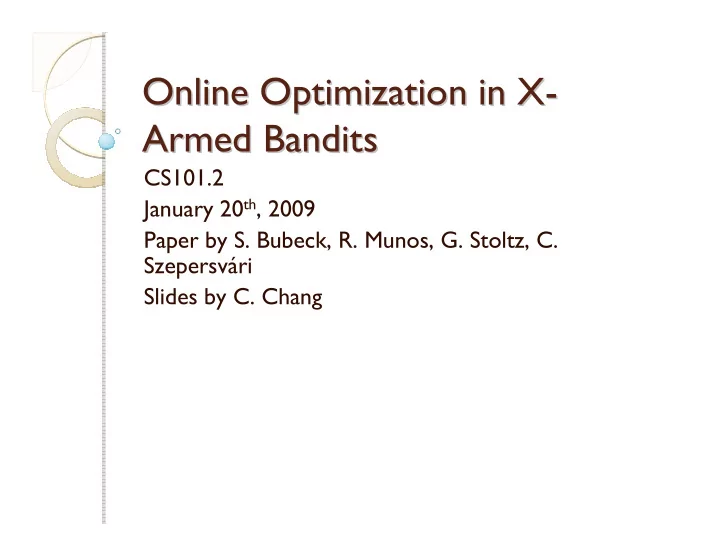

Online�Optimization�in�X� � Online�Optimization�in�X Armed�Bandits Armed�Bandits CS101.2 January�20 th ,�2009 Paper�by�S.�Bubeck,�R.�Munos,�G.�Stoltz,�C.� Szepersvári Slides�by�C.�Chang
Review�of�Bandits Review�of�Bandits � Started�with� k arms ◦ Integral,�finite�domain�of�arms ◦ General�idea:�Keep�track�of�average�and� confidence�for�each�arm ◦ Expected�regret�using�UCB 1 =�O(log� n )
Review�of�Bandits Review�of�Bandits � Last�week � Bandit�arms�against�“adversaries” ◦ Oblivious � O( n 2/3 ) ◦ Adaptive � O( n 3/4 )
Extending�the�Arms Extending�the�Arms � What�about�infinitely�many�arms? � Draw�arms�from� X =�[0,�1] D ◦ D�dimensional�vector�of�values�from�0�to�1 � Mean�payoff�function,� f ,�maps�from� X � � � No�adversaries�(fixed�payoffs)
Extending�the�Arms Extending�the�Arms � What�if�there�are�no�restrictions�on�the� shape�of� f ?
Extending�the�Arms Extending�the�Arms � What�if�there�are�no�restrictions�on�the� shape�of� f ? � Then�we�don’t�know�anything�about�arms� we�haven’t�pulled
Extending�the�Arms Extending�the�Arms � What�if�there�are�no�restrictions�on�the� shape�of� f ? � Then�we�don’t�know�anything�about�arms� we�haven’t�pulled � With�infinitely�many�arms,�this�means�we� can’t�do�anything!
Extending�the�Arms Extending�the�Arms � Okay,�so�no�continuity�at�all�goes�too�far � Generalize�the�mean�payoff�function� function�to�be�“pretty�smooth” � That�way,�we�can�(hopefully)�get� information�about�a�neighborhood�of� arms�from�a�single�pull � We�will�use�Lipschitz�continuity
Lipschitz�Continuity Lipschitz�Continuity � Intuitively,�the�slope�of�the�function�is� bounded � That�is,�it�never�increases�or�decreases� faster�than�a�certain�rate � This�seems�like�it�can�give�us�information� about�an�area�with�a�single�pull
Lipschitz�Continuity Lipschitz�Continuity � Formal�definition: � Function� f(x) is�Lipschitz�continuous�if, � Given�a�dissimilarity�function,� d(x,y) , � f(x)�– f(y)�≤ k�× d(x,y) � k� is�the�Lipschitz�constant
Lipschitz�Continuity Lipschitz�Continuity � For�a�function� f with�a�certain�constant� k ,� we�call�the�function� k� Lipschitz � We’ll�assume�1�Lipschitz� ◦ For�another� k ,�we�can�just�adjust�the�payoffs� to�make�the�function�1�Lipschitz ◦ We’re�really�just�concerned�with�relative� performance�versus�other�strategies�on�the� same� f
Lipschitz�Continuity Lipschitz�Continuity Function�will�stay�inside�the�green�cone (Graphic�taken�with�permission�from�Wikipedia�under GNU�Free�Documentation�License�1.2)
Lipschitz�Functions Lipschitz�Functions � Examples�of�functions�that�are�Lipschitz:
Lipschitz�Functions Lipschitz�Functions � Examples�of�functions�that�are�Lipschitz: ◦ f(x)�=�sin(x) ◦ f(x)�=�|x| ◦ f(x,y)�=�x�+�y
Lipschitz�Functions Lipschitz�Functions � Examples�of�functions�that�are�Lipschitz: ◦ f(x)�=�sin(x) ◦ f(x)�=�|x| ◦ f(x,y)�=�x�+�y � And�functions�that�aren’t:
Lipschitz�Functions Lipschitz�Functions � Examples�of�functions�that�are�Lipschitz: ◦ f(x)�=�sin(x) ◦ f(x)�=�|x| ◦ f(x,y)�=�x�+�y � And�functions�that�aren’t: ◦ f(x)�=�x 2 ◦ f(x)�=�x�/�(x�– 3)
Application Application � Why�would�we�need�a�bandit�arm� strategy�for�non�linear�mean�payoff� functions?
Application Application � One�example:�Modeling�airflow�over�a� plane�wing � A�parameter�vector�is�an�arm � Pulling�an�arm�is�costly ◦ Difficult�to�actually�calculate�(computer� models,�PDEs…) � Still�want�to�maximize�some�kind�of�result� across�the�arms
Developing�an�Algorithm Developing�an�Algorithm � Okay,�so�it’s�useful � What�kind�of�algorithm�should�we�use? � Random? ◦ We’ve�seen�how�well�this�works�out � Other�obvious�approaches�are�less� applicable�with�infinitely�many�arms…
Developing�an�Algorithm Developing�an�Algorithm � We�can�reuse�the�ideas�from�the�UCB 1 algorithm p 1 p 2 p 3 p 4
Adjustments�Needed Adjustments�Needed � Not�discrete�arms,�but�a�continuum ◦ We�will�have�need�a�UCB�for�all�arms�over� the�arm�space � We�can�get�some�confidence�about�any� pulled�arm’s�neighbors�because�of� Lipschitz
Stumbling�Around Stumbling�Around � Not�discrete�arms,�but�a�continuum… [0]�x�D [1]�x�D
Stumbling�Around Stumbling�Around � New�points�affect�their�neighbors [0]�x�D [1]�x�D
Adjustments�Needed Adjustments�Needed � We�can�also�sharpen�our�estimates�from� nearby�measurements � Retain�“optimism�in�the�face�of�the� unknown” � General�idea�gotten…but�how�do�we� actually�do�it?
The�Algorithm! The�Algorithm! � Split�the�arm�space�into�regions � Every�time�you�pick�an�arm�from�a�region,� divide�into�more�precise�regions � Keep�track�of�how�good�every�region�is� through�results�of�itself�and�its�children.
Setup�for�the�Algorithm Setup�for�the�Algorithm � To�remember�regions,�use�a�“Tree�of� Coverings” � A�node�in�the�tree�with�height� h and�row� index� i is�represented�as� P h,i or�just�( h , i ) ◦ The�children�of� P h,i are� P h+1,2i�1 and� P h+1,2i ◦ The�whole�arm�space� X� =� P 0,1 � The�children�of�a�node�cover�their�parent
Setup�for�the�Algorithm Setup�for�the�Algorithm � We�always�choose�a�leaf�node,�then�add� its�children�to�the�tree. � Each�node�has�a�“score” – we�pick�a�new� leaf�by�going�down�the�tree,�going�to�the� side�with�the�greater�score. � Score: B h,i (n)� =�min{ U h,i (n),� max children [ B child ]} where� U h,i (n)� is�the�upper�confidence� bound�for�the�tree�node�( h,i )
Setup�for�the�Algorithm Setup�for�the�Algorithm � One�more�caveat�– For�any�node�( h,i ),� the�diameter�(determined�by� d ,�the� dissimilarity�function)�of�the�smallest� circle�that�bounds�the�node�is�less�than� ν 1 ρ h� for�some�parameters� ν , ρ � A�little�more�formally, U h,i (n)� =� � h,i (n)�+� Chernoff�+� ν 1 ρ h (Chernoff�=�sqrt[(2�ln� n )�/� N h,i (n) ]� )
Setup�for�the�Algorithm Setup�for�the�Algorithm � Score: B h,i (n)� =�min{ U h,i (n),� max children [ B child ]} � What�if�you�have�no�children?
Setup�for�the�Algorithm Setup�for�the�Algorithm � Score: B h,i (n)� =�min{ U h,i (n),� max children [ B child ]} � What�if�you�haven’t�been�picked�yet? � Optimism�in�the�face�of�uncertainty! ◦ Set�B�to�infinity
Algorithm�Example Algorithm�Example f
Algorithm�Example Algorithm�Example f
Algorithm�Example Algorithm�Example Y�=�0.5 f
Algorithm�Example Algorithm�Example Y�=�0.5 f
Algorithm�Example Algorithm�Example f
Observations Observations � Exploration�comes�from�the�pessimism�of� the�B�score�and�the�optimism�of�the� unknown � Exploitation�comes�from�the�optimism�of� the�B�score�and�fast�elimination�of�bad� parts�of�the�function
Numerical�Results Numerical�Results � The�following�is�taken�from�another�talk� by�the�author,�Sébastien�Bubeck
Numerical�Results Numerical�Results
Regret�Analysis� Regret�Analysis� � Not�going�to�go�through�all�the�math ◦ If�want,�read�the�paper... � Pretty�similar�to�regret�analysis�of�UCB 1 ◦ Number�of�times�a�bad�arm�is�chosen�is� proportional�to�log( n )�and�inverse�to� difference�to�best�arm ◦ Add�a�lot�of�mess�from�the�Lipschitzness ◦ Actually,�we�only�require�“weak�Lipschitz”,� which�is�a�sort�of�one�sided�Lipschitz�near�the� best�arms
Regret�Analysis Regret�Analysis � Main�result: � E( R n )�≤ C(d')�n (d'+1)/(d'+2) (ln�n) 1/(d'+2) ◦ C� is�some�constant ◦ d'� is�any�number�greater�than� d ,�and�in�most� cases,�can�be�equal�to� d
Recommend
More recommend